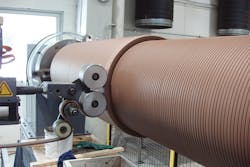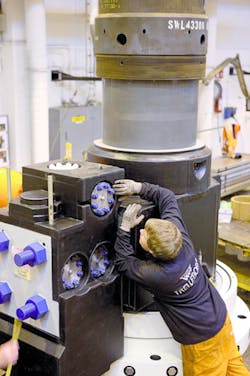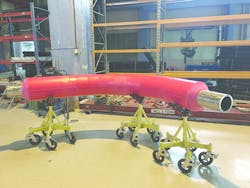Thermal insulation is an integral part of offshore production system design, especially in deep, cold waters. This is because effective insulation of subsea structures helps maintain flow rates, optimize productivity and reduce processing costs. Flow assurance is a critical element of deepwater developments.
However, subsea thermal insulation is perhaps even more pertinent for subsea architecture — insulation materials are used to guard against the buildup of waxes and hydrate crystals in the reservoir fluids, which can occur when the hot fluid (oil or gas) is depressurized and exposed to the low seawater temperature at the seabed or if there is a temporary halt in production. Furthermore, during shutdown, the insulation gives sufficient time for inspection of the pipe and equipment so engineers can have time to solve production problems and for methanol or glycol injection as necessary.
Unchecked, these deposits can quickly build up and cause loss of flow or even a blockage. Downtime means a loss of revenue, and blockages are expensive to rectify, representing a loss on a considerable investment; the greater the depth, the more the value of that investment.
Meeting new extremes
Over the last 10 years, subsea oil production has moved to deeper waters. Depths of 3,500 meters per 10,000 feet and temperatures of up to 180°C (360°F) have been seen. As exploration continues to move into ultradeep waters, the role of subsea thermal insulation on high-pressure, high-temperature wellheads becomes ever more critical.
Flow assurance solutions help enhance safety.
Not only must subsea thermal insulation systems withstand the extreme conditions placed on them — and perform reliably — they must last the lifetime of a project. Until recently, customers required solutions that could last 20 years; now lifetimes of 30 or even 40 years are demanded. The extreme temperatures and hydrostatic loadings have resulted in a need for new insulation materials that can keep up with the increasing requirements placed on them. Many existing insulation materials are incapable of performing under such conditions without an unacceptable risk of degradation and loss of thermal performance.
Operators have responded to the challenge of implementing new and relatively young technologies into their field development solutions by adapting their approaches to the styles and scopes of their own specifications to ensure quality and performance throughout the entire project.
An integrated strategy
Over the last decade, offshore operators have begun looking for more robust solutions to give them the project confidence they need to succeed. Thermal insulation has indeed been augmented in many cases through the addition of electrical heating and chemicals to open up the operation window and allow for reliable field operation in the case of stoppages, startup and even normal operation. System failure is not an option, thus the reliability of a complete thermal management strategy has never been more apparent and the once narrow field of flow assurance has taken on a much more significant role.
A wide range of considerations must be made when evaluating the suitability of a material for subsea thermal insulation applications, and a number of testing programs have been described and prescribed that are aimed at ensuring that the material and overall system are capable for any given application.
An issue of control
In addition to the material aspects of the product, quality assurance and control measures must be taken during application, including those with an emphasis on operation skill levels, qualification of equipment and plant along with documentation; this is because the performance and long-term integrity of a thermal insulation system is as dependent on the quality of its application. Given the complexity of many subsea structures, the application of insulation material can present considerable difficulties especially in terms of access, efficiency and completion schedules.
Inconsistent quality control processes have been one of the main causes of failure for subsea thermal insulation systems in the offshore oil and gas industry over the last 20 to 30 years. Typical issues can include anything from insulation materials applied outside of specified ambient temperature ranges, incorrect mixing ration of raw materials, inadequate substrate preparation, incorrect use of equipment to inadequate training and supervision of operators.
End users have put increasing emphasis on providing concise, quality documentation such as application procedure specifications (APS) and inspection and test protocols (ITP) that, when followed, deliver traceability throughout the entire process. Furthermore, this documentation is generally integrated with quality plans and job cards to ensure that all application steps are recorded and reported. Working this way makes the issue of quality everyone’s responsibility.
In the dark old days, product application could be — and often was — handled by anyone on-site, possibly resulting in poor levels of performance. A specific requirement for documented training programs and keeping of training matrices has largely mitigated this; however, the value of this is only as high as the willingness to enforce.
Changing with the times
In response to the need for better qualification and quality assurance to ensure the reliability of thermal insulation application strategies, leading manufacturers have taken steps to make certain that the industry better understands the characteristics of an efficient and effective insulation system.
One standard that leading manufacturers have implemented is to employ or train field service teams. This allows them to have highly trained professionals on hand to ensure a total insulation service that guarantees product performance and quality at all times.
Significant investments have been made in state-of-the-art mixing and dispensing equipment to make sure that hardware is available that, when expertly utilized, can provide a functional and robust delivery system capable of applying insulation materials to even the most complex subsea equipment structures.
Dispensing equipment and mobile laboratories — housed in specially converted container units — can be modified for project-specific requirements and are designed to ensure ease of mobility. Portable coating facilities can be mobilized in a short time frame and sent straight to a customer’s site, which increases project flexibility and reduces the costs and lead times associated with transporting parts to a specialist coating facility. The use of such facilities in the same country, along with training of local operators, allows for the rising importance of local content in operations.
Manufacturers are more aware that complex fieldwork can incur costs for customers. Collaboration with the client is vital for the ultimate success of the overall construction work. Adequate openness and collaboration on scheduling and order of work can bring significant value to the project in terms of execution and cost and risk savings. For this reason, all site teams should be fully briefed on the requirements of each project well in advance.
Pioneering the way
The trends discussed here have encouraged manufacturers and applicators to develop innovative solutions that can keep up with the increasingly demanding offshore industry. In particular, the use of rubber-based corrosion protection and thermal insulation materials has come to the forefront as a popular solution within the offshore industry. This is at least in part due to rubber’s innate flexibility and durable nature. At the same time, the thermal properties and aging characteristics of many industrial rubbers can be modified to provide thermally efficient systems that show little change over the life of the field. The use of rubber-based solutions has been further promoted with the advent of room autoclave-free vulcanization and low-temperature vulcanization of systems, allowing for field application.
High-temperature, castable systems such as silicones and hybrid epoxy-urethanes are popular choices for application to complex structures. These offer ease of application and enable high degrees of automation to the process.
A third popular high-temperature option, particularly for bends and jumpers, is a thermoplastic thermal insulation and corrosion protection system such as polypropylene. With an excellent combination of resilience, thermal performance and chemical stability, this system can be used at extreme depths and temperatures. When combined with an integral high-quality, fusion-bonded epoxy corrosion coating, the system can be applied as a thin film using spray techniques or as a thick coating using injection-molding technology.
Thermoplastic thermal insulation and corrosion protection system coated on a pipe bend
Conclusion
As the offshore oil and gas industry continues to push the limits when it comes to demanding subsea applications, the need for reliable, durable and portable solutions that deliver proven performance has never been greater.
Add to this the fact that the lifetime of an oil field is expected to increase to 30 to 40 years and design temperatures of the field can vary throughout (up to 180°C [360°F]), and it becomes clear that it has never been more important for materials to prove they can stand the test of time.
Leading manufacturers take significant steps to work with operators to guarantee the reliability, performance and life of a thermal insulation material. Through extensive test programs and qualification, manufacturers can prove the integrity of their service and solutions for the lifetime of the field, providing peace of mind for offshore operators.
Adam Jackson has a wide experience in the oil and gas industry from concepts to projects and operations. Through work within system design, product development and manufacturing, he has a good theoretical and practical appreciation of the pipeline and subsea architecture industry. As a technology manager, Jackson is responsible for technical and developmental aspects of Trelleborg’s existing and future thermal insulation portfolio. Visit trelleborg.com for more information.





